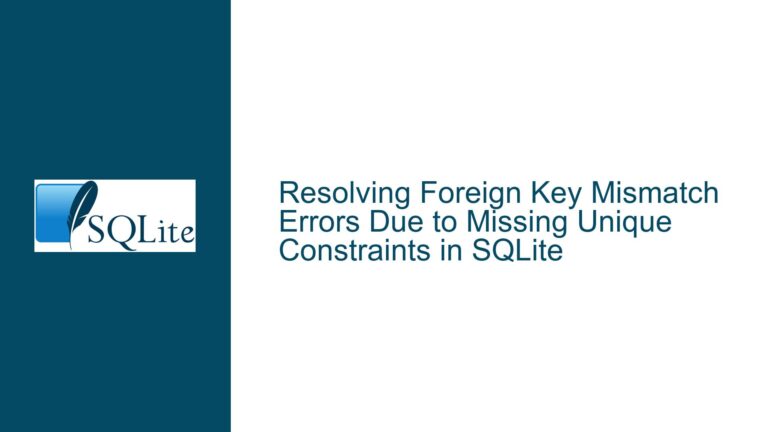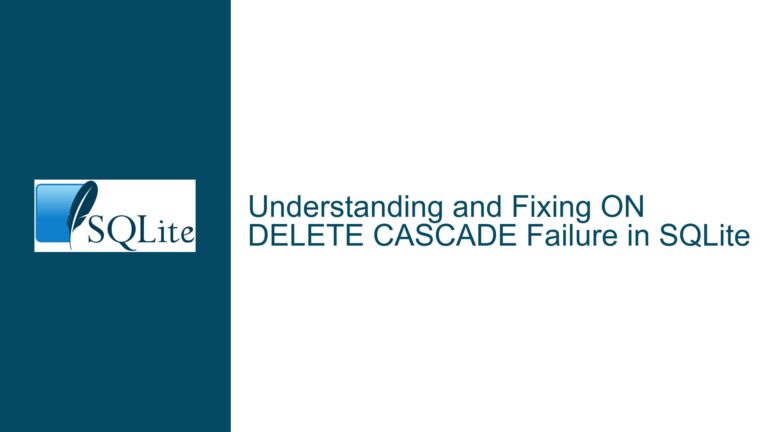SQLite Virtual Table Access Issue in Custom Schema
Issue Overview: Virtual Tables in Custom Schema Not Accessible
The core issue revolves around the inability to access virtual tables (vtabs) when they are registered in a custom schema within SQLite. The user attempted to create a loadable extension that exposes a set of eponymous virtual tables, which are designed to be accessible without explicit creation. These virtual tables were named with a common prefix (ext_name_vtab_name) to avoid naming conflicts. However, the user found the naming convention cumbersome and sought to organize the virtual tables into a separate schema for better namespace management.
To achieve this, the user implemented a custom Virtual File System (VFS) analogous to memdb but capable of operating in Write-Ahead Logging (WAL) mode. This custom VFS was used to attach an in-memory database with a specific schema name (ExtName). The virtual tables were then successfully registered within this schema using the CREATE VIRTUAL TABLE statement. However, when attempting to query these virtual tables from the host application (e.g., DB Browser), the queries failed with a "no such table" error, regardless of whether the schema name was included in the query.
The user expected the virtual tables to be accessible both with and without the schema name prefix, assuming that the fully qualified name (ExtName.vtab_name) or the unqualified name (vtab_name) would resolve correctly. However, the virtual tables remained inaccessible, indicating a potential issue with how SQLite handles virtual tables in custom schemas.
Possible Causes: Schema Resolution and Eponymous Virtual Table Behavior
The issue appears to stem from a combination of factors related to schema resolution and the behavior of eponymous virtual tables in SQLite. Eponymous virtual tables are designed to exist in all schemas, meaning they should be accessible regardless of the schema context. However, the current behavior suggests that this feature may not be functioning as intended, particularly when the virtual tables are registered in a custom schema.
One possible cause is a regression in the handling of eponymous virtual tables, which may have been introduced during the development of SQLite version 3.9.0. This version marked the introduction of eponymous virtual tables, and it is possible that changes made during this period inadvertently affected their behavior in custom schemas. The regression hypothesis is supported by discrepancies in the test files (tabfunc01.test), which show conflicting expectations for the behavior of eponymous virtual tables in different schemas.
Another potential cause is the interaction between the custom VFS and SQLite’s schema resolution mechanism. When a custom VFS is used to attach a database, SQLite may not fully integrate the attached schema into its internal schema resolution logic. This could result in the virtual tables being registered but not properly recognized when queried from the host application. Additionally, the use of an in-memory database (file:/host?vfs=mdb) may introduce complexities in how SQLite manages schema visibility and table resolution.
Finally, the issue could be related to the way SQLite handles the registration of virtual tables in custom schemas. While the CREATE VIRTUAL TABLE statement successfully registers the virtual tables within the ExtName schema, SQLite may not be updating its internal catalog to reflect the presence of these tables in the schema. This would explain why queries fail with a "no such table" error, as SQLite’s catalog would not contain the necessary metadata to resolve the table names.
Troubleshooting Steps, Solutions & Fixes: Resolving Virtual Table Access Issues
To address the issue of inaccessible virtual tables in a custom schema, several troubleshooting steps and potential solutions can be explored. These steps aim to identify the root cause of the problem and provide actionable fixes to ensure that virtual tables are accessible as expected.
Step 1: Verify Schema Attachment and Virtual Table Registration
The first step is to confirm that the custom schema (ExtName) is correctly attached and that the virtual tables are properly registered within this schema. This can be done by executing a series of diagnostic queries to inspect the schema and table metadata.
-- Check if the schema is attached
PRAGMA database_list;
-- List all tables in the ExtName schema
SELECT name FROM ExtName.sqlite_master WHERE type = 'table';
If the schema is not listed in the PRAGMA database_list output, the attachment process may have failed. In this case, review the ATTACH statement and ensure that the custom VFS is correctly implemented and accessible. If the virtual tables are not listed in the sqlite_master table, the CREATE VIRTUAL TABLE statements may not have been executed successfully. Verify that these statements are being executed in the correct context and that there are no errors during registration.
Step 2: Test Eponymous Virtual Table Behavior in Different Schemas
Next, test the behavior of eponymous virtual tables in different schemas to determine if the issue is specific to the custom schema or a general problem with eponymous virtual tables. This can be done by creating an eponymous virtual table in the main schema and querying it from different contexts.
-- Create an eponymous virtual table in the main schema
CREATE VIRTUAL TABLE main.vtab_name USING module_name;
-- Query the virtual table from the main schema
SELECT * FROM main.vtab_name;
-- Query the virtual table from the custom schema
SELECT * FROM ExtName.vtab_name;
If the virtual table is accessible in the main schema but not in the custom schema, this suggests that the issue is related to schema resolution rather than the virtual table implementation itself. If the virtual table is inaccessible in both schemas, the problem may lie with the eponymous virtual table feature or the virtual table module.
Step 3: Review and Update the Custom VFS Implementation
If the issue is related to the custom VFS, review and update the VFS implementation to ensure that it correctly integrates with SQLite’s schema resolution mechanism. Pay particular attention to how the VFS handles schema attachment and table registration. Ensure that the VFS updates SQLite’s internal catalog with the necessary metadata for the attached schema and virtual tables.
Consider implementing additional logging or debugging output in the VFS to track the schema attachment and table registration process. This can help identify any discrepancies or errors that may be causing the virtual tables to be inaccessible.
Step 4: Modify the Virtual Table Module to Support Custom Schemas
If the issue persists, consider modifying the virtual table module to explicitly support custom schemas. This may involve updating the module’s xCreate and xConnect methods to handle schema-specific registration and resolution. Ensure that the module correctly identifies the schema context and updates SQLite’s catalog accordingly.
Additionally, consider implementing schema-specific initialization logic in the virtual table module to ensure that the virtual tables are properly registered and accessible in the custom schema. This may involve adding custom logic to handle schema attachment and table registration within the module.
Step 5: Explore Alternative Solutions and Workarounds
If the above steps do not resolve the issue, explore alternative solutions and workarounds to achieve the desired functionality. One possible workaround is to use a different naming convention for the virtual tables that avoids the need for a custom schema. For example, use a shorter prefix or a different naming strategy that minimizes the risk of naming conflicts.
Another workaround is to use a different database engine or extension mechanism that better supports custom schemas and virtual tables. For example, consider using a different lightweight database that provides more robust support for custom schemas and virtual tables, or explore alternative extension mechanisms that may offer better compatibility with SQLite’s schema resolution logic.
Step 6: Engage with the SQLite Development Community
Finally, if the issue remains unresolved, consider engaging with the SQLite development community to seek further assistance and guidance. Share detailed information about the issue, including the steps taken to troubleshoot and any relevant code or configuration files. The community may be able to provide additional insights or identify potential fixes that were not previously considered.
By following these troubleshooting steps and exploring the potential solutions and fixes outlined above, it should be possible to resolve the issue of inaccessible virtual tables in a custom schema and ensure that the virtual tables are accessible as expected.






